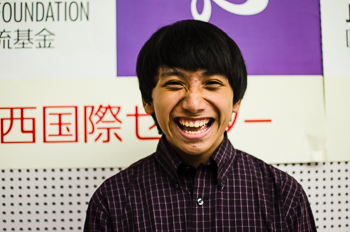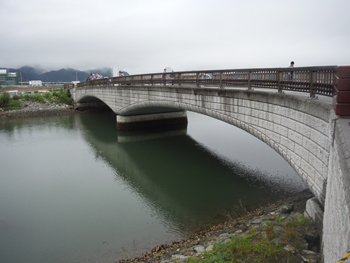

 Na Xiong
Na Xiong
Pleasant Valley High School
Chico, CA
Dear reader, my name is Na Xiong and I come from a small college town in Northern California called Chico. I also had the honor of being the 2013 group representative and gave two speeches, one in English and the other in Japanese. Before the 2013 JET Memorial Invitation Program I had never flown in a plane or been overseas. The program introduced me to many new and spectacular things not available in America or California. During the program I was introduced to many different people from all over the states and Japan. When we landed in Japan we were all tired and in need of showers but despite the exhaustion the excitement of being in Japan kept us going strong.
During the visit to the Tohoku Region we were met with rainy weather. Like the humidity in Osaka we were hit with rain and wind as we exited Hanamaki airport. Us mippers had the opportunity to help each other prepare lunch and were able to listen to a presentation about the Tohoku disaster. Like us, the high school students were learning about the Tohoku region and how it affected the area around Eastern Takata Junior High School. The students of the school ate lunch with us, helped us in calligraphy, and played games with us. The interactions between the junior high students helped us understand each other more and the activities allowed us to create bonds even though there was an age and culture gap. The students made a human tunnel for us to pass through as we left the school and we also made a human tunnel for them to go through. The human tunnel showed me how similar we were with the Japanese students even though we live half way around the world from them. During this program we also had the opportunity to meet many other schools and students. We visited East Takata Junior High School, East Sendai High, Watanoha Elementary, Ishinomaki Koubunkan High School, Semboku High School and students from the Rikuzentakata and Kessenuma area. This experience helped show me that we all share many of the same hobbies and like the same kind of music and books. The experience was surprising but it allowed us to connect with complete strangers even if our Japanese and/or English skills were not the best. The Japanese students from Ishinomaki and some of us Mippers even formed a group called Jet Jidai, sort of like the popular group Shoujo Jidai. What I discovered in Japan was that it is English friendly, even if I had no knowledge of Japanese, the people of Japan and their kindness or even limited knowledge would be enough to help guide me in Japan. The students were very outgoing and kind. If people didn’t know, I am usually the more reserved and quiet type of person. But the positive energy of the Japanese students allowed me to become more outgoing. Before visiting the Tohoku region I thought the people would be sad or depressed. In America if a disaster occurred people would not be able to or want to share their experience but the Japanese people were very open about their stories and wanted their stories to be heard. This surprised me but it also showed me how strong the Japanese people are and even though they suffered and lost many things they are still happy and energetic.
The 2013 Program gave us two homestay opportunities. I stayed with the Satoh family in Sendai and the Yamauchi family in Osaka. Both families showed me the daily life of Japanese people and gave me a new view of Japanese people. Instead of the normal Tokyo or textbook stereotypes I got a glimpse of how Japanese people really lived. The people of the Tohoku region were more reserved but were the kindest, calmest and had the biggest and strongest hearts. On the contrary, the people of Osaka were more loud, funny and easygoing. Overall, the Japanese people are very kind to everyone. One fact that surprised me was that my Sendai host family was from Kessenuma so the stories I told about my visit to the Kesssen area was familiar. The radical difference between the Japanese and Americans were very apparent when we landed at LAX. In LA we were met with overly rude people and radically different air. Before the heading to Japan, Anna Lee, the 2012 Jet-MIP representative told us to smell the Japanese air. The air in Japan smells sweeter or somehow I can’t explain it but it is truly different from the air in LA and California. Another thing I miss is that the mosquitoes in Japan did not leave me with red itchy bumps.
Even though I may not be able to major or take classes in Japanese in college, I know for a fact that I will not forget the language, people and culture. The program inspires me to pursue some study of Japanese language and culture in college or even to study abroad in Japan. The numerous JET ALT’s and CIR’s helped inspire and give me hope about continuing my Japanese studies and perhaps to become a JET. The experience in Japan and the knowledge given to me by the JET’s, gives me hope that I will be able to continue my study of the Japanese language.
After experiencing and learning about Japan I told my family not only about the destruction of the Tohoku Region but also I told them about the kindness of the Japanese people. Some family members still aren’t fully convinced what I tell them really occurred because it still seems so hard to believe that many cities like Ishinomaki or Rikuzentakata were completely flooded by the tsunami. The fact that my family was most surprised about was that many of the areas hit by the disaster are still not recovered and is still in construction. I was also surprised by this fact too. The experience inspires me to share my knowledge of 3.11 when I go to college this fall.
To Ms. Taylor Anderson and Mr. Monty Dickson, you both inspired me with your love of Japan and its culture and language. Your stories inspire me to do the same things you both did and maybe to try and surpass what you have given to Japan and America. Even though both of your lives were cut short because of the Great East Japan Earthquake and tsunami, your love of Japan still continues to build more bridges and inspires more people every day. So Thank you, for showing me your Japan and showing how I can help build the bridges between America and Japan and how I can share my experiences of Japan and of the memories you both left behind. I promise that I will never forget you both or your stories and Japan. And hopefully Japan doesn’t forget about me or the 2013 JET Memorial Invitation Program.

“Meeting Half Way”
This is the bridge we crossed to reach the tiny island where the tree of hope stood with a memorial pedestal. I chose this photo because it represented a bridge like the one between America and Japan. What is missing in the bridge between Japan and America is that Americans are lacking in their side of the bridge. Like this bridge because it symbolizes the need for American and Japan to meet in the middle so that our relationship can remain strong and last a long time. America is now cutting a lot of its Japanese language programs and so that is not helping the bridge. Instead we Americans need to make sure that we can keep Japanese culture and language classes open to others.